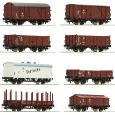Brawa 67725 Leichtbaukesselwagen Uerdingen ZZr, DR, Ep.III
Delivery time: 3 ‐ 10 business days (Germany)
Check availability in store:
- Store Oschatz: currently unavailable
Share with friends:
Brawa 67725 Leichtbaukesselwagen Uerdingen ZZr, DR, Ep.III Product Details
About the model: BRAWA combines quality and a prototypical look in the model of the DR lightweight tank wagon Uerdingen ZZR and thus expands its range with another detailed model on a scale of 1:160. The wagon has a prototypical look with the finest printing and other details such as brake shoes at wheel level and extra buffers. The model also has a length of 77.5 mm and has been given the road number "51-71-36 [P]".
About the prototype: In the years 1939/40, the wagon factories Köln-Deutz and Uerdingen each developed a four-axle tank car in lightweight construction. In direct connection with this, Westwaggon also created the prototype of the tub tender with which the BR 42 and 52 war locomotives were later coupled. The development was driven in particular by the military, as huge quantities of crude oil and fuel had to be transported for supplies. In order to make maximum use of the available steel contingent, the lightweight construction was exploited to the maximum, as with all wartime designs - as soon became apparent, however, at the expense of durability. Both manufacturers now developed wagons with self-supporting boilers. While Deutz left it at head pieces, the Uerdingen design also had longitudinal beams made of folded profiles, which were intended to help absorb the longitudinal compressive forces. The main data of both variants were identical: The length over buffers was 12.40 m, the bogie pivot distance was 6.60 m and the boiler had a capacity of 63 m3. Due to the compact design, this volume led to axle and meter load problems, so that the boiler could not be completely filled on all lines. Press plate bogies with a wheelbase of 2.00 m were used as running gear. The wagons built up to 1945 were used by Wifo and the oil associations to supply the Wehrmacht. After 1945, various European companies rebuilt the wagons in a more advanced form, including Tatra in Prague in 1946. In 1955, SEAG delivered almost 500 cars developed from the Uerdingen design to the United States Transportation Corps (USTC). Due to the events of the war, many wagons were lost or remained with other European state railroads. The wagons located in the catchment area of the western occupation zones were transferred to VTG, which emerged from the former Wifo in 1951. In addition, mineral oil companies used further wagons as P-wagons and acted as the main tenants of the VTG wagons. The wagons remaining with the DR remained in the state railroad's fleet and were only leased out on a long-term basis, primarily to the PCK Schwedt/Oder. The last wagons were only removed from the fleet in the 1990s and were often still used as rail service or station wagons. They could often still be seen in this function after the turn of the millennium.
Features:
- Gauge: N
- Era: III
- road number: 251-71-36 [P]
- Length over buffers: 77.5 mm
- Close coupler kinematics
- Brake shoes at wheel level
- Extra attached buffers
- Prototypical frame construction
- Free-standing address boards
- Precise printing and paintwork
- Metal wheels
Specs:
- Type: Tank wagon
- Gauge: N
- Rail Company: DR
- Era: III
- Color: Grey
- News: 2023
Further links:
CAUTION: Not suitable for children under 3 years. Danger of swallowing! Age recommendation from 14 years.
Achtung! Maßstabs- und originalgetreue Kleinmodelle sowie Elektrozubehör für erwachsene Sammler. Nicht geeignet für Kinder unter 14 Jahren
Zum Betrieb des vorliegenden Produkts darf als Spannungsquelle nur ein nach VDE 0570-2-7/DIN EN 61558-2-7 gefertigter Spielzeug-Transformator verwendet werden.












